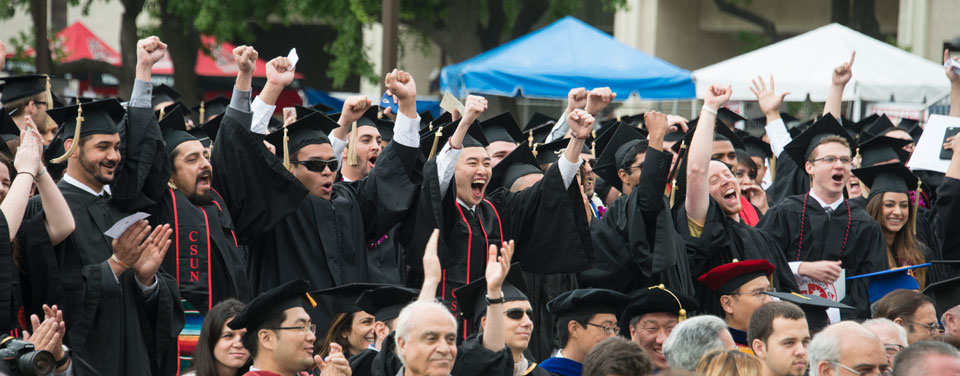CSUN Tapping Technology to Accelerate Student Success
California State University, Northridge administrators and student advisers this fall are harnessing technology to shine a light on student academic performance data, with the goal of accelerating students’ progress toward graduation. Partnering with Washington, D.C.-based think tank Education Advisory Board, CSUN is using the organization’s new Student Success Collaborative software to synthesize information on students’ grades, courses completed (or dropped) and progress toward graduation — using the data throughout the university’s student advising centers. For the first time, those academic advisers can instantly access and fully use this secure and private information by department and major.
“This kind of capability is brand new to CSUN,” said Vice Provost Michael Neubauer, who is spearheading the campus’ use of the online tool. “The ability to find groups of students really changes the way advising can be done on this campus. This fall, each advising center is running a campaign [for this tool]. We’ve asked them to identify criteria — low GPA, for example. We want to find 500 students and do intensive intervention and advising, and develop a plan with each of them to graduate.
“Students may be progressing, but they could be excelling with the right support,” said Neubauer, a mathematician by training and proponent of data analysis to track student progress. “For example, they may be getting reasonable grades in their general education classes, but they’re struggling in their major courses. They may need a referral to the campus Career Center.”
University leaders are employing the new tool for the campus’ largest student body in CSUN history — and one of the largest in the nation — at more than 41,500 students enrolled this fall semester. With students spread across its colleges, advisers previously relied on CSUN’s Office of Institutional Research for data searches on student progress.
“[The new tool] puts the advisers in charge,” Neubauer said. “Previously, the students that advisers would see were mandatory, such as those on academic probation — or others who were naturally proactive and self-motivated.”
Now, advisers can monitor groups of CSUN students within certain majors, departments and colleges who, for example, have experienced a recent decrease in their grades — or withdrew from several classes.
“It opens the doors for a conversation with an adviser,” Neubauer said. “If we don’t get the student in to talk, we cannot help. We want to use this to get students to graduation.”
CSUN’s new partnership with the Education Advisory Board will provide the university with “the tools, services and predictive analytics that will help in a variety of areas, including targeted advising, assessing high-impact practices and reducing bottlenecked courses,” President Dianne F. Harrison said in her annual fall welcome address to faculty and staff in late August. “And we now have a user-friendly dashboard that is available to colleges and departments that will provide important data for decision-making to support student persistence and success.
“Even with our growing student population, we continue to make good progress with retention,” Harrison continued. “We also need to ensure that these trends translate into greatly improved graduation numbers and lower achievement gaps.”
CSUN has worked with the think tank for a number of years but only recently decided to deploy the online platform, Neubauer said. The university participates in the organization’s nationwide information technology and academic affairs forums. The new tool, Student Success Collaborative, incorporates all CSUN students’ academic data from the past 10 years, and the organization developed a custom-made tool to suit the campus, he said.
“We can look at aggregate data, and we can look at individual grades, but the platform does something unprecedented: It dynamically intersects both and provides a snapshot,” said Reza Sayed, interim director of the Student Services Center/Education Opportunity Program (EOP) satellite for the College of Engineering and Computer Science. “It can alert us to follow up with students — which has, for some students, made all the difference between feeling anonymous and feeling that someone cares and checks up on them.
“While we’re moving toward using more technology, our meetings with students will paradoxically become more personal and human,” Sayed said. “The program lets us quickly reveal key points of interest in a student’s record, so that we can efficiently address academic issues and move on to other possible contributing factors. We have a large population of non-traditional students: first-generation college students, students employed full-time, students working one to three part-time jobs, veterans returning to school after several years of deployment. Each individual has a unique story that accompanies the data.”
The tool enhances CSUN’s efforts to help students complete their degree.
“The Student Success Collaborative will help the provost’s office and the satellite offices identify students who show early signs of not making good progress according to their chosen degree path,” said Yi Li, provost and vice president for academic affairs. “I want to encourage students to meet with an adviser and map out a plan for success.”
CSUN’s advising centers, which include EOP and every academic college, can use the new tool as part of an existing, comprehensive effort to meet student needs, Sayed noted.
“When I ask an auditorium full of incoming freshmen, ‘How many of you plan to graduate in four years?’ — almost everyone will have a hand raised,” Sayed said. “Part of our job as advisers is to help these students reach their initial goal. The platform lets us use empirical evidence to guide our conversations with students and to identify obstacles to reaching their goals.”


 experience
experience